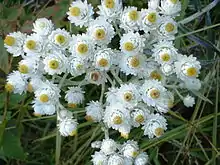Anaphalis margaritacea
Anaphalis margaritacea, commonly known as the western pearly everlasting[5] or pearly everlasting,[6] is an Asian and North American species of flowering perennial plant in the sunflower family. It is widespread across most of the United States and Canada, as well as northwestern Mexico.[7][8] Asian populations are found in China, the Russian Far East, Japan, Korea, northern Indochina, and the Himalayas.[9] The species is reportedly naturalized in Europe though not native there.
| Anaphalis margaritacea | |
|---|---|
 | |
| Close-up photo of the capitula | |
| Scientific classification | |
| Kingdom: | Plantae |
| Clade: | Tracheophytes |
| Clade: | Angiosperms |
| Clade: | Eudicots |
| Clade: | Asterids |
| Order: | Asterales |
| Family: | Asteraceae |
| Genus: | Anaphalis |
| Species: | A. margaritacea |
| Binomial name | |
| Anaphalis margaritacea | |
| Synonyms[4] | |
|
Synonymy
| |
Anaphalis margaritacea grows erect up to about 1.2 meters (3 ft 11 in)[10] and has narrow, alternate leaves. One salient feature is that the undersides of the leaves are covered in tiny hairs, giving them a woolly feel and appearance. The stems are dry and brittle. The small whitish to yellowish flower grows in a corymb inflorescence. The inflorescence's most conspicuous part is the numerous white bracts that surround the disc florets;[7] these are pearly in color, even when dried, the reason for the species' common name.[11]
The plant is dioecious, meaning the pollen-producing (male) and seed-producing (female) flowers are borne on separate plants. It prefers dry, sunny climates, although it is hardy to temperatures well below freezing. The leaves and young plants are edible when cooked.[12]
The leaves are host to the caterpillars of the American painted lady butterfly (Vanessa virginiensis)[13] and the painted lady butterfly (Vanessa cardui).[14]
- Varieties and subspecies[4]
- Anaphalis margaritacea var. cinnamomea (DC.) Herder ex Maxim.
- Anaphalis margaritacea subsp. japonica (Maxim.) Kitam.
- Anaphalis margaritacea var. margaritacea
- Anaphalis margaritacea var. yedoensis (Franch. & Sav.) Ohwi
References
- NatureServe (2006). "Anaphalis margaritacea". NatureServe Explorer: An online encyclopedia of life, Version 6.1. Arlington, Virginia.
- "Anaphalis margaritacea". International Plant Names Index (IPNI). Royal Botanic Gardens, Kew. Retrieved 2008-06-08.
- "Anaphalis margaritacea". Germplasm Resources Information Network (GRIN). Agricultural Research Service (ARS), United States Department of Agriculture (USDA). Retrieved 2008-06-08.
- "Anaphalis margaritacea". The Global Compositae Checklist (GCC) – via The Plant List.
- "Anaphalis margaritacea". Natural Resources Conservation Service PLANTS Database. USDA. Retrieved 8 January 2016.
- "BSBI List 2007". Botanical Society of Britain and Ireland. Archived from the original (xls) on 2015-01-25. Retrieved 2014-10-17.
- Nesom, Guy L. (2006). "Anaphalis margaritacea". In Flora of North America Editorial Committee (ed.). Flora of North America North of Mexico (FNA). 19. New York and Oxford – via eFloras.org, Missouri Botanical Garden, St. Louis, MO & Harvard University Herbaria, Cambridge, MA.
- "Anaphalis margaritacea". County-level distribution map from the North American Plant Atlas (NAPA). Biota of North America Program (BONAP). 2014.
- Zhu, Shixin; Bayer, Randall J. "Anaphalis margaritacea". Flora of China. 20–21 – via eFloras.org, Missouri Botanical Garden, St. Louis, MO & Harvard University Herbaria, Cambridge, MA.
- C. Michael Hogan (2010). "Anaphalis margaritacea". Encyclopedia of Life.
- Fagan, Damian (2019). Wildflowers of Oregon: A Field Guide to Over 400 Wildflowers, Trees, and Shrubs of the Coast, Cascades, and High Desert. Guilford, CT: FalconGuides. p. 27. ISBN 978-1-4930-3633-2. OCLC 1073035766.
- "Pearly everlasting (Anaphalis margaritacea)".
- "Vanessa virginiensis". Butterflies and Moths of North America.
- The Xerces Society (2016), Gardening for Butterflies: How You Can Attract and Protect Beautiful, Beneficial Insects, Timber Press.
External links
 Media related to Anaphalis margaritacea at Wikimedia Commons
Media related to Anaphalis margaritacea at Wikimedia Commons Data related to Anaphalis margaritacea at Wikispecies
Data related to Anaphalis margaritacea at Wikispecies
